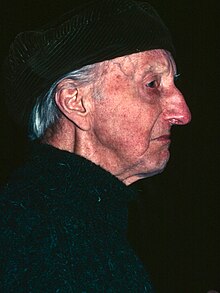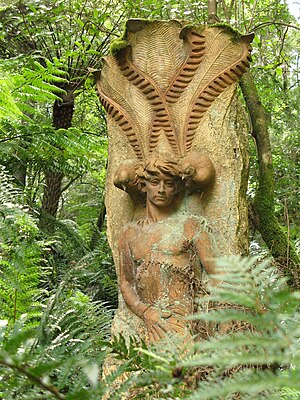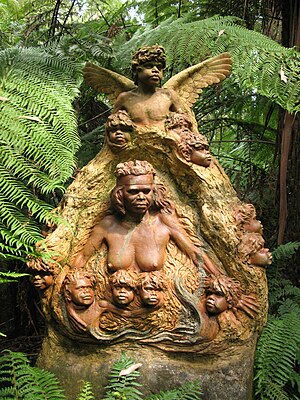William Ricketts


William Ricketts (1898–1993) was an Australian potter and sculptor of the arts and crafts movement.
Born in Richmond, Victoria, in 1898, William settled permanently in Mount Dandenong, Victoria, in 1934. Although not trained as a potter and never technically superior (his works, large and small, frequently exhibit cracking), the power of his vision of a modern Australia that embraces Aboriginal spirituality and respect for the natural world was his general message throughout his artworks.
His major works include the "Dromana" in the Seawinds Garden, Arthurs Seat, Victoria, and "Gun Brute" at the William Ricketts Sanctuary, Mount Dandenong, Victoria. Many smaller works are in the collection of the Powerhouse Museum in Sydney. Photographic records of his sculptures, particularly those from the sanctuaries of Pitchi Richi and Mount Dandenong, which have been vandalised, are held in the archives of Australia's libraries. Ricketts, never rich, supported himself through commissioned sales of his art and made pieces as gifts. These signed original small pieces are increasingly sought after for private collections.
From 1949 to 1960 he made frequent trips into Central Australia to live with Pitjantjatjara and Arrernte Aboriginal Australians, whose traditions and culture inspired his sculpture. He was not an Aboriginal by blood but considered himself adopted by the Pitjantjatjara nation. He left many of his central Australian works at Pitchi Richi near Alice Springs – a bird sanctuary run by his friend Leo Corbet – as he considered the landscape integral to these sculptures.
From 1912 to 1920 Ricketts developed skills in playing violin, crafting jewellery, and clay modelling. In 1934 he started his major artistic work, creating the sculpture park now named William Ricketts Sanctuary. He worked on this project until his death in 1993. In the 1970s, he spent two years in India, mostly at the Sri Aurobindo Ashram spiritual centre in Puducherry, developing spiritual empathy with Indian people and knowledge of their philosophy.
To many, including academics such as Marcia Langton, Bruno David and Mitchell Rolls, Ricketts is considered a controversial figure with his beliefs and his sculptures steeped in racism, exploitation and primitivism. Ricketts is viewed to have a white saviour complex and is quoted as believing he had been 'called to the defence of the aborigines and the continent' and that 'my creator worked through the Australian aborigine to get hold of me'. Ricketts compares his own personal distress over the environment to the suffering of the Aboriginal People. His trips to central Australia were viewed as controversial and filled with misunderstanding and tensions with Ricketts having incorrect preconceived notions of the roles of the Anangu people.[citation needed]
There is a biography, "Whitefella dreaming: the authorised biography of William Ricketts" by Peter Brady, published 1994.[1]
William Ricketts Sanctuary

Ricketts' major work is in the sculpture park that he named Potter's sanctuary, but which is now known as William Ricketts Sanctuary. In the 1960s the Victoria State Government bought the Sanctuary from Ricketts, and made it a public park. Ricketts lived there until his death in 1993.[2]

Storm damage
On 9 June 2021, a severe storm in the Dandenong Ranges caused extensive damage to William Ricketts Sanctuary. Many buildings and sculptures were damaged by fallen trees and branches. Parks Victoria is continuing to work on a plan to make the site safe, but it is going to take longer than other sites due to the sheer scale of the damage and the artistic and cultural importance of the sculptures. At this stage, there is no specific date when the Sanctuary will re-open, but it is not expected to be during 2024.[3]
References
- ^ Biography. Publication information: Victorian Government Library Service [1]
- ^ "William Ricketts Sanctuary (William Ricketts Sanctuary)". Parks Victoria.
- ^ "William Ricketts Sanctuary (William Ricketts Sanctuary)".
Further reading
- Langton, Marcia; David, Bruno (2003). "William Ricketts Sanctuary, Victoria (Australia)". Journal of Material Culture. 8 (2): 145–168. doi:10.1177/13591835030082002. ISSN 1359-1835. S2CID 162349878.
- Mitchell Rolls (28 May 2018), "Friday essay: William Ricketts Sanctuary is a racist anachronism but can it foster empathy?", The Conversation
